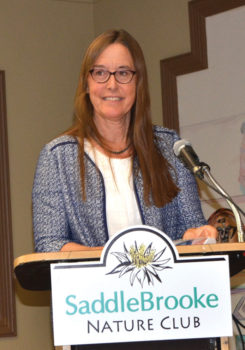
Holly Richter, speaker for SaddleBrooke Nature Club
Pam Boedeker and JoAnn Waddell
Holly Richter, the Arizona Water Projects Director for the Arizona Chapter of The Nature Conservancy, provided an overview of Colorado River Basin water issues to the SaddleBrooke Nature Club on March 10. The watershed of the Colorado River encompasses essentially the entire state of Arizona, including large tributary streams like the Salt, Verde and San Pedro Rivers. The massive size of the Colorado Basin includes not only two countries, but nine states (seven in the U.S. and two in Mexico). A total of about 36 million people depend on the river system, and more than four million acres of farmland is irrigated with its water.
Paddlewheel steamboats historically brought goods and people from the mouth of the Colorado River Delta upstream to Yuma and as far upstream as Nevada. But today the waters of the Colorado no longer even reach the sea at its delta. Without freshwater from the river mixing with ocean water, the rich and productive fisheries and other habitats that typically prosper in delta environments are no longer present. Today the expansive Colorado River’s delta was normally dry until a monumental effort to reconnect the river with the ocean occurred in 2014.
Thanks to the world’s first international agreement to allocate water for environmental purposes, developed between the U.S. and Mexico, water was allocated for a one-time event to restore flows to the river. The river had not reached the sea since 1998 and before then it has only reached the sea sporadically since 1963, when Lake Powell started filling. But due to an unprecedented level of international cooperation, farmers in Mexico agreed to leave additional water that was allocated to them in Lake Mead for a large “pulse flow” of the river. This was contingent on them having water efficiency measures put in place that would reduce how much water they actually needed to grow their crops. Conservation groups, including The Nature Conservancy, helped provide funding in support of this innovative agreement.
Scientists from both countries anticipated that this water would rejuvenate the habitats along the river and allow native streamside plants to germinate. Extensive scientific measurements and photographs were taken of how the water actually flowed through the river as it made its way downstream many miles by The Nature Conservancy and other agencies and organizations. The beneficial effects that resulted after the event in terms of both plants and animals were also observed by scientists for many months. And, as hoped, the river did, at least for a short time, reconnect with the sea and bring new life to the river and its delta. This event provided scientists and water managers in both countries with a better understanding of the measures that would need to be taken to restore flows on a more permanent basis in future years.
SaddleBrooke Nature Club meets the second Monday of the month at 4:00 p.m. in the Coyote Room downstairs in HOA 1. For more information go to www.SaddleBrookeNatureClub.com.
